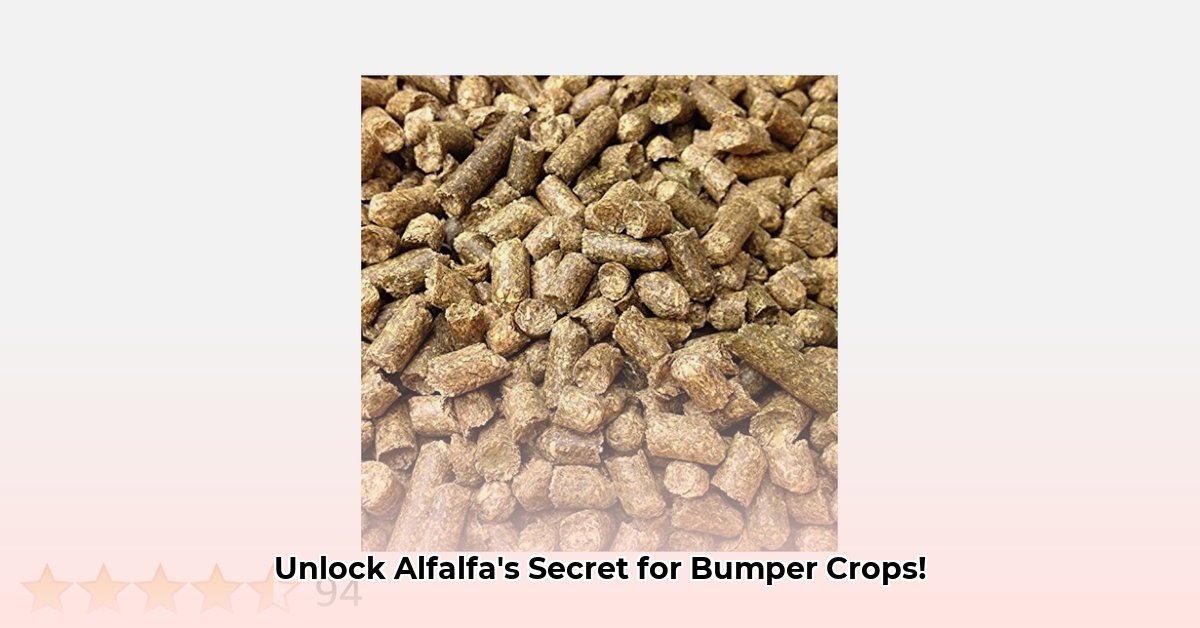
Tractor Supply Alfalfa Pellets: A Comprehensive Guide for Sustainable Farming
This guide provides actionable strategies for maximizing the benefits of Tractor Supply alfalfa pellets while promoting sustainable agricultural practices. We will cover pellet selection, sustainable sourcing, effective feeding strategies, and cost-benefit analyses to help you optimize your livestock nutrition and minimize environmental impact. For information on other Tractor Supply feed options, check out this helpful resource.
What are Alfalfa Pellets?
Alfalfa pellets are a concentrated form of alfalfa, a highly nutritious legume. The alfalfa is dehydrated and compressed into small, easy-to-handle pellets, preserving essential nutrients like protein, vitamins, and minerals. This makes them a convenient and consistent feed source compared to loose hay, which can vary in nutritional value depending on weather and growing conditions. However, improper sourcing or storage can lead to nutrient loss or mold growth, highlighting the importance of choosing a reputable supplier and following proper storage guidelines.
Choosing the Right Alfalfa Pellets for Your Livestock
Selecting the appropriate alfalfa pellets involves several key steps:
Identify Your Livestock: Different animals have unique nutritional needs. Choose pellets specifically formulated for your livestock's species (e.g., horses, cattle, goats).
Consider Life Stage: Young, growing animals require different nutritional profiles than mature adults. Pregnant or lactating animals also have increased nutritional demands. Carefully review the pellet packaging for age and life-stage recommendations.
Define Your Goals: Are you aiming for weight gain, maintenance, or specific health improvements? Your feeding objectives will influence your pellet choice. For example, animals needing to gain weight may need a higher-calorie pellet.
Review Nutritional Information: Scrutinize the pellet packaging for details on protein content, fiber, minerals, and vitamins. Ensure these meet your livestock's specific dietary necessities. Consult a veterinarian or animal nutritionist if you are unsure.
Quality Control: Inspecting Alfalfa Pellets Before Purchase
Before purchasing, always inspect the pellets:
Check for Mold or Discoloration: Discard any bags exhibiting mold, discoloration, or damage, as these indicate spoilage.
Assess Pellet Consistency: Uniform pellet size and shape are crucial. Inconsistent pellets suggest potential manufacturing issues.
Verify Protein Content: Ensure the listed protein content aligns with your animals' requirements. Discrepancies may indicate subpar quality.
Sustainable Sourcing: Minimizing Your Environmental Impact
Sustainable sourcing is paramount for responsible farming:
Source Transparency: Inquire about the origin of the alfalfa and the manufacturing processes employed. Prioritize suppliers committed to environmentally friendly practices.
Water Conservation: Support suppliers utilizing water-efficient alfalfa production methods. Water scarcity is a growing concern impacting sustainable agriculture.
Sustainable Pest Management: Favor suppliers prioritizing integrated pest management (IPM) techniques that minimize pesticide use. IPM methods protect both the environment and the animals consuming the feed.
Soil Health: Responsible alfalfa cultivation maintains soil health. Support suppliers who prioritize soil conservation practices. Healthy soil leads to higher-quality alfalfa.
Practical Application and Usage: Storage and Feeding Regimens
Effective pellet utilization necessitates proper storage and feeding:
Storage: Keep pellets in a dry, cool, well-ventilated area, shielded from direct sunlight and moisture.
Feeding Guidelines: Follow the package instructions carefully. Start with smaller amounts, gradually increasing based on your livestock’s consumption and requirements. Regularly monitor your animals' response to the pellets.
Troubleshooting: If animals refuse pellets, inspect for mold or other issues. Consider adjusting the feeding schedule or supplementing with other feed sources.
Cost-Benefit Analysis: Alfalfa Pellets vs. Other Feed Options
While alfalfa pellets might initially seem more expensive than loose hay, they often offer long-term cost savings due to reduced waste and easier handling. A careful cost-benefit analysis is warranted. (Note: A detailed cost comparison would require specific pricing data for your region.)
Conclusion: Sustainable Practices for a Thriving Farm
Effective utilization of Tractor Supply alfalfa pellets requires meticulous selection, proper storage, and thoughtful feeding strategies. By following these guidelines, you can ensure your livestock receive consistent, high-quality nutrition, minimize waste and labor costs, and promote environmentally responsible farming practices. Remember that continuous learning and adaptation are key for optimal outcomes.
Pivotal Points:
- Consistent nutrient delivery in alfalfa pellets compared to hay improves animal health and growth.
- Strategic sourcing ensures sustainable practices, minimizing environmental impact.
- Proper storage and feeding reduce waste and optimize cost-effectiveness of pellet usage.